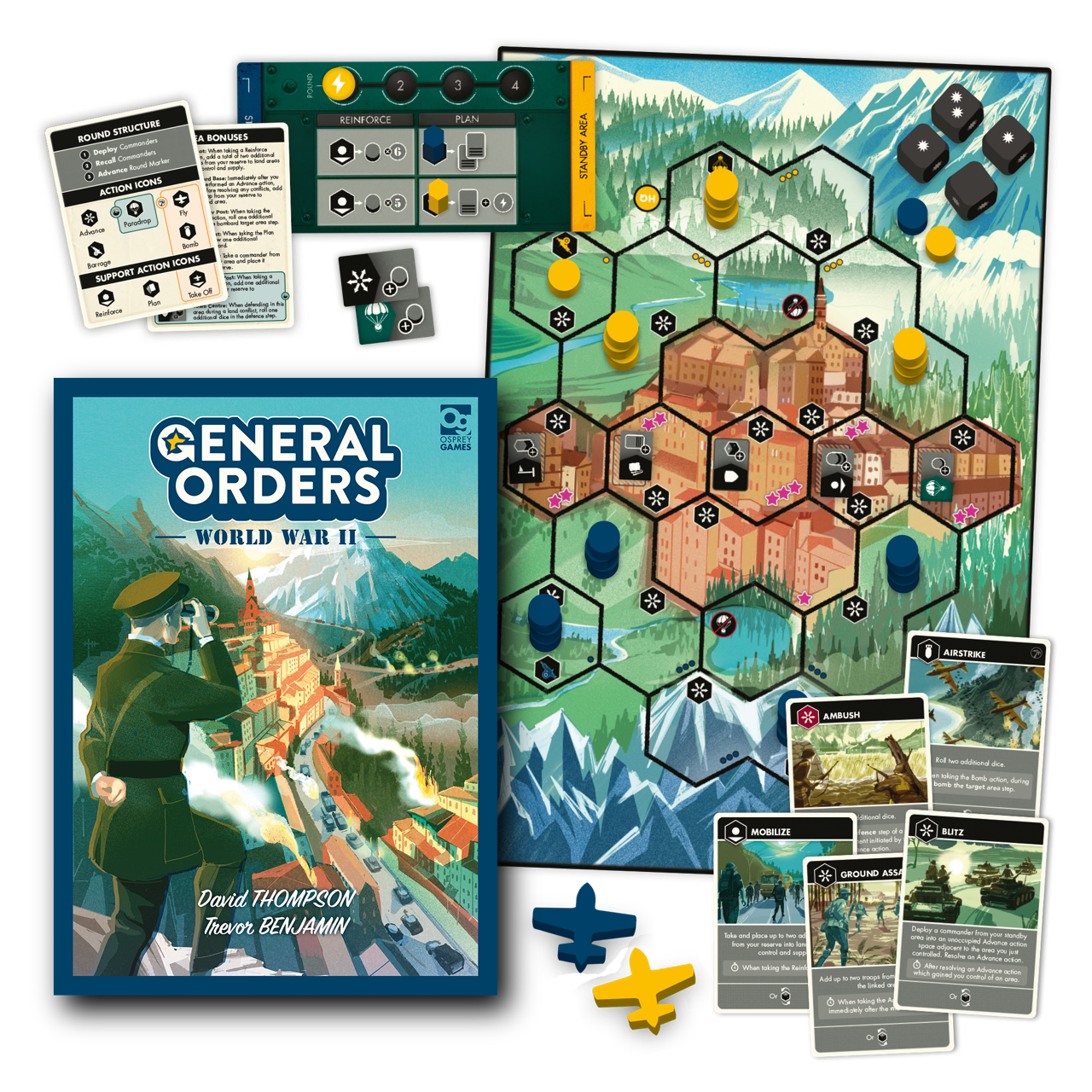13 March 2024
|
A WW2 themed strategy game designed by legendary duo David Thompson and Trevor Benjamin roars to life in General Orders: World War II. The game breaks new ground as a worker placement wargame, with high strategy but low play time – and we consider it a Must Play Game.
Written by George Barker
What Is General Orders: WW2 Game?
As you sit down at the table and survey your battle lines, the rulebook will tell you that you must knock out your opponent’s HQ. Simple. It’s only a few spaces behind the front line. A concentrated push at their weakest point and it will all be over by Christmas. You play out the first round and it’s going well, you’ve surged up the board, grabbing territory, secured supply lines and bagged a few bonus abilities to help the push.
By the end of round 2, however, the confidence of an early victory is beginning to disappear. As the frontlines become entrenched, you realise just how hard it is to attack. It requires overwhelming numerical advantage and the attrition rate is high. As you consider the cost of taking a single hex, the idea of a decisive victory begins to slip away. Instead, you’ll have to play for the alternate victory condition; hold territories with the most victory points at the end of the game. Just like that, General Orders conveys a sense of bitter struggle and grand strategic decision making in just 25 minutes.
How do you play General Orders: World War II?
Billing itself as the first ‘worker-placement wargame’, General Orders plays out over 4 rounds in which players take it in turn to deploy their commanders (the workers) to action spaces on the board. Like any worker-placement game, placing a commander onto an action space blocks the other player from using it. Attacking is costly and requires overwhelming numbers to overcome the defender’s advantage but comes with the relative safety of knowing that a counterattack cannot take place until commanders are recalled at the end of the round and the action space in the captured hex is freed up.

While not as exciting a tagline as Osprey Games might think, it turns out worker-placement and wargaming make a great pairing. Deploying commanders to key action spaces early might deny something to your opponent yet the longer you hold off, the more information you’ll gain about where to best focus your efforts. For a small box, General Orders manages to distil some big strategic ideas. It’s not just a game of attrition; cut enemy troops off from supply and they’ll be unable to act. Clever manoeuvres or surgical artillery barrages can render an otherwise superior force useless.
Each turn presents the dilemma of responding to your opponent’s last move or pushing ahead with your own strategy. Thinking too tactically in General Orders is often a path to defeat. If you only ever react and counter your opponent’s moves, you give them the luxury of setting the game’s tempo and it’s unlikely you’ll make gains of your own. Achieving a meaningful breakthrough requires planning, accruing troops in the right place and finding the time to gather a hand of the game’s action cards that will give you a critical edge.
Getting to grips with the game’s possibilities is very satisfying and repeat plays feel rewarding, especially with a double sided board offering two scenarios to play. With an art style straight from a travel poster, the two maps are a symmetric battle in mountainous northern Italy and an asymmetric assault on a Pacific island. Each has their own mechanical and strategic quirks. In the mountains, paratroops let you outmanoeuvre the frontline stalemate while aircraft add an extra layer in the Pacific.
While the scenarios take some inspiration from theatres of the Second World War, the theming is otherwise very light compared to the designers’ previous historical titles. Arguably this only makes the game more accessible to non-wargamers and means no one is stuck having to play as the Axis powers.
General Orders manages more interesting choices in 25 minutes than many games manage in an hour. It concentrates wargaming down into a pocket-size box that’s quick to teach and hard to put away without a second play.
Should you play General Orders: World War II?
We rate it a must-play game.
General Orders’ accessibility makes it a great way to introduce strategy games while offering enough strategic depth that it will still appeal to seasoned commanders.
Try this if you liked... Caesar!
If you like short bursts of sweating over strategy but still want the tactile satisfaction of moving troops around a map, General Orders is hard to beat.
Designer: Trevor Benjamin & David Thompson
Publisher: Osprey Games
Time: 30 minutes
Players: 2
Age: 14+
Price: £25
What’s in the box?
- Double-sided game board
- Support action board
- Wooden pieces: 18 Commanders, 50 troops, 20 aircraft
- Round marker
- 7 area bonus tokens








Comments
Login or register to add a comment
No comments